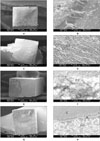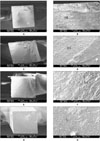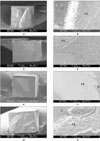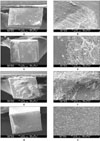Abstract
In all experimental groups applied with 2% chlorhexidine, the microtensile bond strength increased, and thermocycling decreased the microtensile bond strength (P > 0.05).
Compared to the thermocycling groups without chlorhexidine, those with both thermocycling and chlorhexidine showed higher microtensile bond strength, and there was significant difference especially in GI and TS groups.
SEM analysis of failure mode distribution revealed the adhesive failure at hybrid layer in most of the specimen, and the shift of the failure site from bottom to top of the hybrid layer with chlorhexidine groups.
Figures and Tables
 | Figure 4SEM images of fractured surfaces after microtensile bond strength testing of SM.
(A) No CHX/No Thermocycle (× 100) (B) No CHX/No Thermocycle (× 2000) (C) No CHX/10,000cycles (× 100) (D) No CHX/10,000cycles (× 2000) (E) CHX/No Thermocycle (× 100) (F) CHX/No Thermocycle (× 2000) (G) CHX/10,000 cycles (× 100) (H) CHX/10,000 cycles (× 2000)
A,B show adhesive failure. C,D show adhesive failure at the bottom of hybrid layer and resin tag are broken or left out of dentinal tubules. E,F show adhesive failure at hybrid layer intertubular dentin seems to be completely covered by adhesive (DT: dentinal tubule, C: composite resin, HL: hybrid layer).
|
 | Figure 5SEM images of fractured surfaces after microtensile bond strength testing of SB.
(A) No CHX/No Thermocycle (× 100) (B) No CHX/No Thermocycle (× 2000) (C) No CHX/10,000cycles (× 100) (D) No CHX/10,000cycles (× 2000) (E) CHX/No Thermocycle (× 100) (F) CHX/No Thermocycle (× 2000) (G) CHX/10,000 cycles (× 100) (H) CHX/10,000 cycles (× 2000)
A,B show adhesive failure at hybrid layer. C,D show mixed failure at the bottom of hybrid layer. G,H show mixed failure at top of the hybrid layer.(HL: hybrid layer, DT: dentinal tubule)
|
 | Figure 6SEM images of fractured surfaces after microtensile bond strength testing of TS.
(A) No CHX/No Thermocycle (× 100) (B) No CHX/No Thermocycle (× 2000) (C) No CHX/10,000cycles (× 100) (D) No CHX/10,000cycles (× 2000) (E) CHX/No Thermocycle (× 100) (F) CHX/No Thermocycle (× 2000) (G) CHX/10,000 cycles (× 100) (H) CHX/10,000 cycles (× 2000)
G,H show the shift of the failure site from the bottom to the top of the hybrid layer. (DT: dentinal tubule, HL: hybrid layer, C: composite resin)
|
 | Figure 7SEM images of fractured surfaces after microtensile bond strength testing of GI.
(A) No CHX/No Thermocycle (× 100) (B) No CHX/No Thermocycle (× 2000) (C) No CHX/10,000cycles (× 100) (D) No CHX/10,000cycles (× 2000) (E) CHX/No Thermocycle (× 100) (F) CHX/No Thermocycle (× 2000) (G) CHX/10,000 cycles (× 100) (H) CHX/10,000 cycles (× 2000)
|




 PDF
PDF ePub
ePub Citation
Citation Print
Print







 XML Download
XML Download